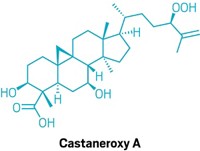Advertisement
Grab your lab coat. Let's get started
Welcome!
Welcome!
Create an account below to get 6 C&EN articles per month, receive newsletters and more - all free.
It seems this is your first time logging in online. Please enter the following information to continue.
As an ACS member you automatically get access to this site. All we need is few more details to create your reading experience.
Not you? Sign in with a different account.
Not you? Sign in with a different account.
ERROR 1
ERROR 1
ERROR 2
ERROR 2
ERROR 2
ERROR 2
ERROR 2
Password and Confirm password must match.
If you have an ACS member number, please enter it here so we can link this account to your membership. (optional)
ERROR 2
ACS values your privacy. By submitting your information, you are gaining access to C&EN and subscribing to our weekly newsletter. We use the information you provide to make your reading experience better, and we will never sell your data to third party members.
Biological Chemistry
Benefits Of Proanthocyanidins
February 13, 2012
| A version of this story appeared in
Volume 90, Issue 7
An interesting sidebar to Stu Borman’s Science Concentrate on anti-UTI mannosides (C&EN, Dec. 5, 2011, page 36) is the similar effect of the proanthocyanidins (PACs) that give the North American cranberry its red color. As long ago as the 1950s, some physicians began to recommend cranberry juice for its prophylactic effect in patients with recurrent urinary tract infections (UTIs). More recently, laboratory studies not only have confirmed the physicians’ anecdotal evidence but have also uncovered PACs as the active agents (Phytochemistry,DOI: 10.1016/S0031-9422(99)00573-7).
In addition, related work has shown that PACs, like the mannosides described in Borman’s article, fight UTIs by blocking the pili that Escherichia coli use to adhere to the cells lining our urinary tracts. Consequently, PACs don’t kill the bacteria, they evict them and, as with the mannoses, this minimizes the development of resistant strains.
By Dale Vitale
Union, N.J.




Join the conversation
Contact the reporter
Submit a Letter to the Editor for publication
Engage with us on Twitter